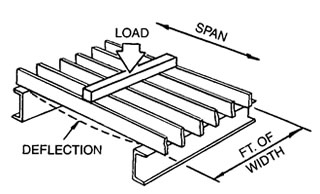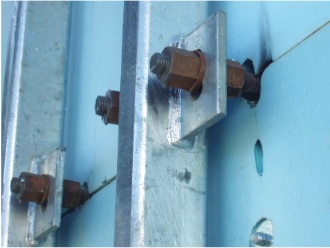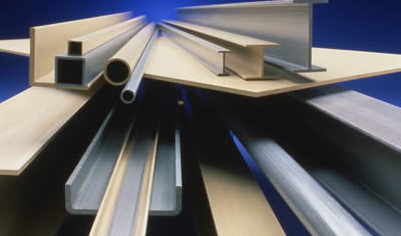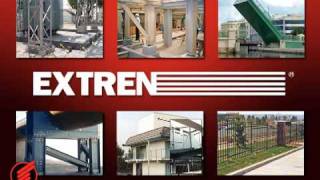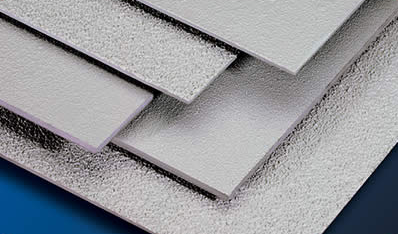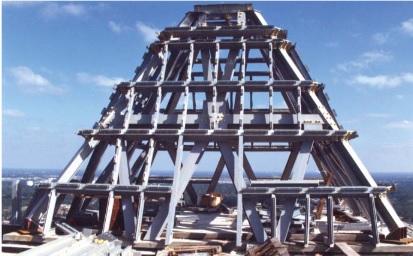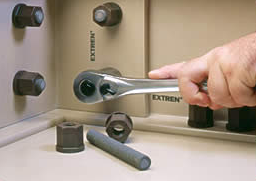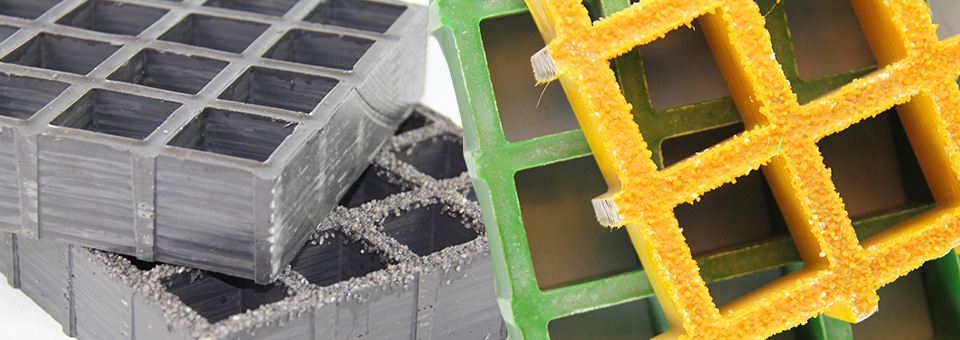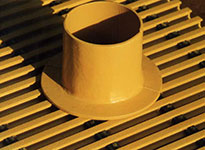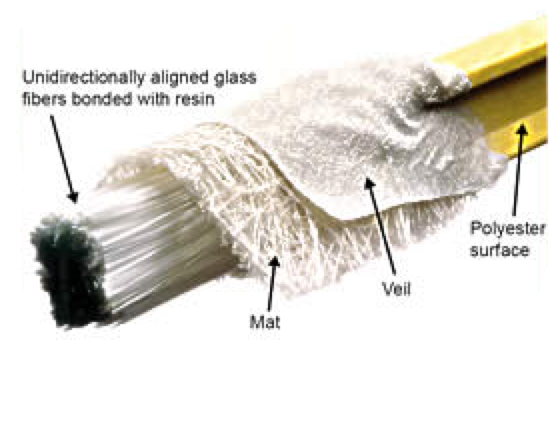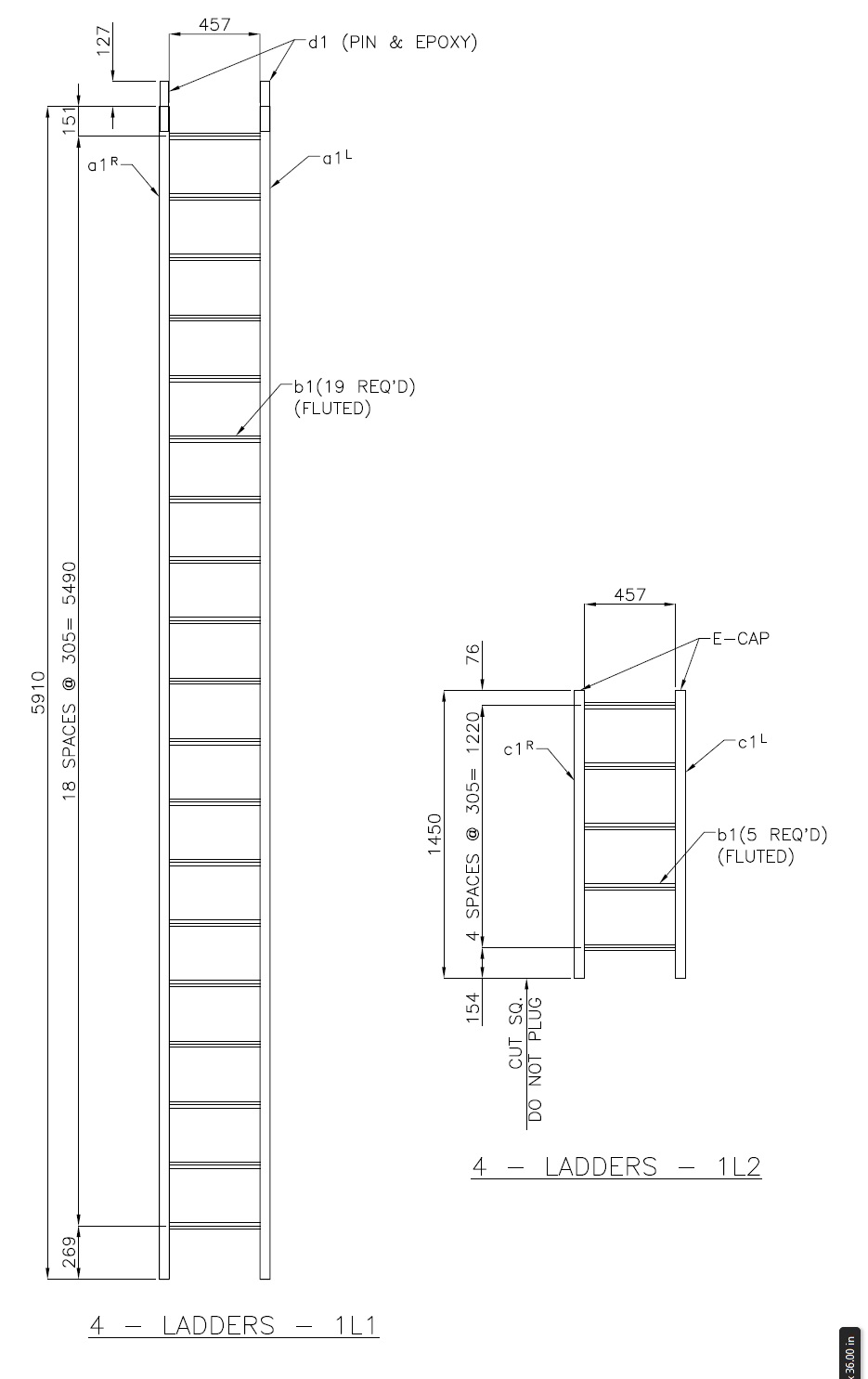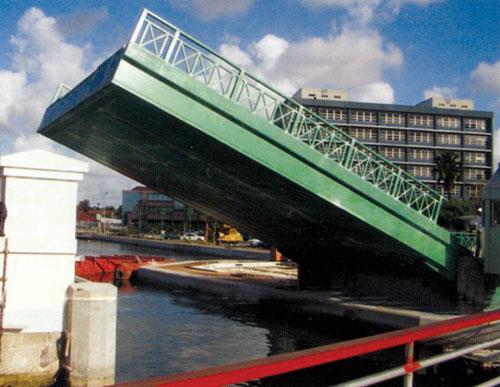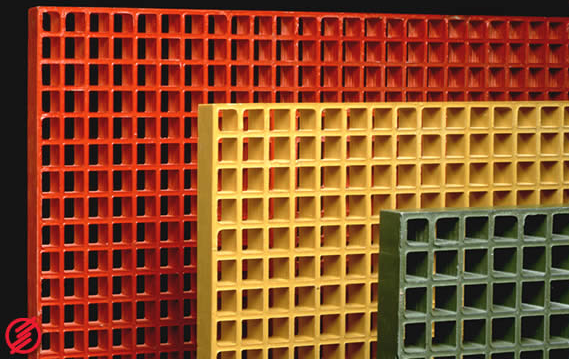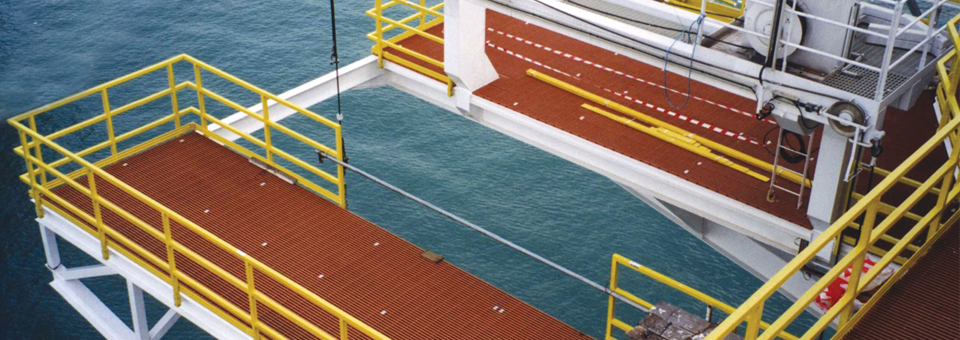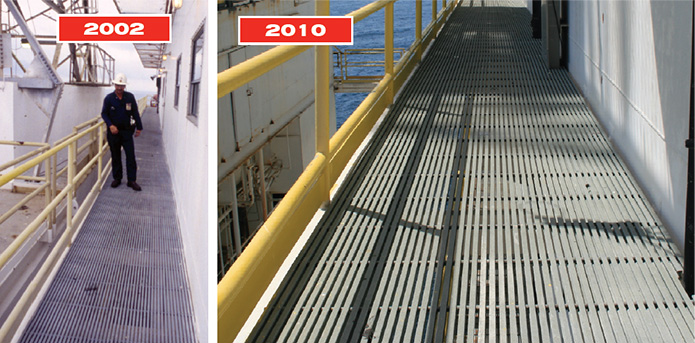News
Deflection and Design
When customers ask about fiberglass reinforced plastic (FRP) grating a question we’re commonly asked is “how strong is it?” compared to traditional materials. The answer is that FRP is very strong and can be used in virtually any situation metal or wood can. Despite FRP being extremely strong it is also more flexible than other materials, especially metal. This means deflection becomes a concern and in many cases is the primary factor to keep in mind as a designer considers the project. What happens when a span is too large is that the deflection factor increases so much that it makes the surface uncomfortable or unstable to walk on. In effect, the grating is storing energy from a footstep and releasing it like a spring. In the case that deflection is too high in the original design, the designer has essentially two choices.
Firstly, the designer can reduce the span distance, which will reduce the deflection and allow the original choice of grating to be used. If the span cannot be altered, a thicker grating profile can be selected in some cases. If the thicker grating cannot be selected; however, then the span distance simply must be reduced.
For a brochure with load tables for many common grating profiles click here.
Solution Spotlight: FRP As A Thermal Break
A customer of Redco FRP’s manufacturer, Strongwell, in Alaska was fabricating a hospital and was facing a unique challenge. Alaska experiences very dynamic temperature changes throughout the year: from 90 degrees Fahrenheit in the summer to -40 in the winter. With traditional metal building materials “thermal transference” can occur which results in condensation between the internal and external walls of the building. In the case of the Bassett Army Community Hospital, the designer wanted to minimize this thermal transference and was willing to consider alternative materials.
The solution ended up being EXTREN channels but also FIBREBOLT 3/4″ FRP threaded rod and nuts to affix the FRP. The reason for this is that metal-on-metal contact increases thermal transference and thus FIBREBOLT was a necessary component of the solution. The FRP components affixed to the structural steel framing system provided a thermal barrier reducing condensation caused by thermal transference. For more information on this application read about it on the original newsletter here.
Fabrication Capabilities
While our website tends to show our products in terms of “stock” shapes and items such as lengths of EXTREN I-beams or standard sizes of pultruded grating, the fact is we’re often asked to provide fiberglass reinforced plastic (FRP) parts with various degrees of fabrication or added services. These services can be as simple as cutting stock shapes or grating to size but other services are offered too. We can supply drilled parts or paint them with a polyurethane based top coat (which also adds more UV-resistance). We are sometimes asked to provide a solution partially assembled, for example an FRP stair kit would have the stringers pre-drilled and assembled with the stair treads but not with the accompanying hand rails. The most important information regarding fabrication is the sealing of the “fingers” when grating or stock shapes are cut down. The exposed fiberglass can be sealed by us with epoxy, but this is not a standard service when FRP is cut-to-size. So if you need sealed fingers – please let us know!
For answers to your questions about our ability to fabricated FRP, please contact us.
EXTREN – More Than Shapes
When Fiberglass structural shapes is discussed, the brand Redco EXTREN is usually associated. But EXTREN is far more than some I-beams, tubes, and angle in fact EXTREN is an entire resin series, which includes plate and grating. Redco EXTREN comes in three types which offer different advantages:
EXTREN 500: The 500 series is a polyester resin and has a standard color of olive green. It is recommended for basic applications in an environment that is not heavily corrosive. This is the “economy” grade product and though it does not include a fire-retardant, it does include include a UV-inhibitor.
EXTREN 525: The 525 series is also a polyester resin but has the additional benefit of added fire retardant. Its color is grey.
EXTREN 625: The 625 series is the premium offering of the bunch. In addition to fire retardancy, EXTREN 625 uses a vinyl ester resin instead of polyester. This gives the material very high corrosion and chemical resistance when compared to the polyester resin versions of the EXTREN product. The standard color of the product is beige.
Remember that various properties of EXTREN products are customizable. Not only color but other properties such as choosing to add grit or certifying the product as NSF 61 safe for potable water. The EXTREN product line needs to be looked at as a resin series with a much wider array of available products and solutions than simple shapes! You can find our EXTREN brochure by clicking here.
For answers to your questions about Redco EXTREN please contact us.
FRP Application Checklist
When a project specifies fiberglass reinforced plastic (FRP) we sometimes do not receive all the information we need to quote a solution. It’s not as simple as “build this, quote the cheapest option” (which we do get!). In fact, we’ve had our time wasted and also delayed our customer’s solutions as we and other bidders end up providing very different solutions both in quality and cost for the same build. The result is quotations, and decisions, are not made “apples to apples”. If you are an engineer working on a project, or a purchaser approaching us for pricing, having pre-answered these questions in advance will lead to a quicker, more accurate quotation:
-How corrosive is the environment? (this may affect resin selection)
-Is color important, what color is required?
-Does the product require fire retardant properties?
-Do we need to supply a freight charge with the quote?
-Does the product require certifications (such as NSF 61 safe for potable water)?
-If the product involves grating, does the grating require grit?
-If grating is specified, do you know the thickness?
-Do you need all materials to be manufactured in the USA?
In addition, drawings are critical to virtually any project we must quote. Please supply them along with any quote request. If you want technical advice designing your project, we can connect you with the Strongwell Design Manual. You can contact Redwood Plastics here.
Don’t Slip With SAFPLATE
Some fiberglass reinforced plastic (FRP) products really stick out: grating, yellow fiberglass ladders & handrails, COMPOSOLITE building panels and EXTREN structural shapes, in particular get a lot of attention. One product that doesn’t get enough attention is Redco SAFPLATE by Strongwell. SAFPLATE is a molded gritted FRP plate available in thicknesses from 1/4″-1″ and a 48″ x 96″ standard panel size. The panels are available in all three EXTREN resin formulas: 500, 525, and 625. What’s unique about SAFPLATE is that you also get to select your type of grit from fine, medium, coarse and extra coarse.
SAFPLATE was designed to provide an anti-slip surface in extreme environments where corrosion, moisture, electrical hazards and other environmental traits exist that would make traditional materials like metal and wood unsuitable. SAFPLATE is extremely low maintenance and will not rot, rust, corrode, conduct electricity, or support mold or fungal growth. It is used in everything from walkways, to grating covers, to trench covers. Custom colors are available though minimum orders may apply.
If you have questions on Redco SAFPLATE or are looking for a quote please contact us.
Cellular Visual Shielding
Fiberglass reinforced plastic (FRP) has a proven track record of excellent performance in the visual shielding of cellular antennas. The antennas need to be covered for aesthetic reasons but materials used need to transparent to cellular signals: metal will not work. Strongwell FRP products, distributed by Redwood Plastics under the name “Redco FRP”, have been extensively tested – most notably by the Los Angeles Research Report (L.A.R.R.). This report requires stringent testing, from 3rd parties, and tests mechanical, UV, fire and weathering properties. The test was also done on a wide range of materials from Redco EXTREN, to DURASHIELD building panels, SAFPLANK, and even FIBERBOLT fiberglass studs and nuts.
The reasons Redco FRP is so beneficial in cellular tower visual shielding applications is because the products are:
Virtually transparent to Cellular Emissions / Frequencies
- Lightweight
- Corrosion / Rot Resistant
- Virtually Maintenance-Free
- Durable / Impact Resistant
We can quote your visual shielding jobs that specify Strongwell products. To get a quote contact us today.
Fabricating Redco FRP
Sometimes plastics such as fiberglass reinforced plastic (FRP) come off as ‘exotic’ materials and people believe they’re difficult to work with and fabricate themselves. Truth is, for most plastics, including FRP, fabrication is easy and relatively straight forward. FRP, like wood, can be sawed, drilled and in certain cases, sanded. But you do need to realize that you are dealing with a product that is essentially glass contained within a plastic resin. Glass is extremely abrasive so diamond or carbide tipped blades and drill bits are a must. Also, you need to realize that FRP fabrication is going to produce a lot of dust so a mask is critical but so is working in a space that is either easy to clean or using some sort of apparatus to suck the dust away as you work (even then, expect some dust to get airborne and spread).
Also important is to recognize that when you cut into FRP you lose the protection that the plastic resin supplies. Those properties such as corrosion-resistance or being impermeable to moisture are lost. For example, cutting into Redco grating the “fingers” that are exposed are susceptible now to the elements. Many of our branches carry sealant if we perform fabrication work on the product but in case you’re wishing to purchase some for yourself “Toolmates Insulating Epoxy Coating” is what we use. Lastly, there is the topic of “sanding”. Sanding should not be done on FRP under most circumstances because, like cutting into it, you wear away the protective resin and make the product vulnerable. The exception to this, where you do want to sand is on the Redco EXTREN product line, particularly when fastening I-beam type products together. In these situations the ideal bond is both mechanical and chemical where the I-beam is sanded on the spots where the 45 degree FRP angle will be attached. A bonding agent is then applied to the sanded part of the I-beam and the angle is pressed against it. A bolt is then passed through a pre-drilled hole through the angle and the EXTREN securing the angle to the beam.
We hope that sheds some light on what is involved in FRP fabrication. If you have more questions feel free to contact Redwood Plastics.
Is FRP Right For Your Application?
While FRP (Fiberglass reinforced plastic) is an excellent product with many advantages over traditional materials such as aluminum, wood and steel, it is not always going to be a fit for every application. We spend a lot of time espousing the advantages of FRP but that doesn’t mean it’s universally the best material under all circumstances.
First of all: if you’re simply shopping for a “cheaper” material than the wood or metal you’re using now, FRP is very likely not going to be less expensive in comparison to traditional materials. This is a common misconception because unfortunately when customers think “plastic” the word “cheap” comes to mind. However, engineering plastic materials such as FRP have a premium cost to go along with their premium properties they offer. In the absence of any benefits the FRP offers an application over traditional materials, it may likely won’t satisfy your need for simply a cheaper product.
Another circumstance FRP would not be ideal, at least in a grating application, is where you have a large span in excess of 48″. The issue is deflection, or “bounce”, of the grating with such a wide span. While the grating will not break, it will be unstable enough for the people walking on it so as to make it unsafe. Ideal spans are 18″-24″. The last point of concern is temperature: FRP materials experience loss of strength above 150 degrees Fahrenheit, so the product is not advisable for use in environments with operating environments that are at or exceed 150 degrees. To be clear FRP has excellent cold weather performance!
The good news is that whether you’re looking for a lower life-cycle cost for your project, less maintenance, corrosion-resistance, ease of installation, electromagnetic transparency, lightweight material or countless other advantages – then FRP is probably the optimal material for the job! If you have questions about the suitability of FRP for your project please contact us.
Grating Availability
When customers request a quote on Redco FRP materials there’s a disconnect at times in that customers think every profile we offer is stocked. With such large inventory as FRP grating and EXTREN profiles we simply cannot carry much stock in our warehouses. But there are a few profiles of grating our branches do tend to stock:
4′ x 10′ x 1.5″ thick molded grating: usually stocked in yellow and grey and almost always with a grit surface. The holes measure 1.5″ x 1.5″
4′ x 12′ x 1.5″ thick molded grating: usually stocked in yellow and more available at our Canadian branches.
4′ x 10′ x 1.5″ thick mini-grid: grey in color, grit surface with 3/4″ x 3/4″ holes. These are commonly used in dock/marine applications.
We occasionally carry some black mini-grid as well as 4′ x 8′ sheets but the profiles above are the most likely you’ll find in stock at any time. If a quick turnaround for your order is needed, consider using one of those three profiles if at all possible.
For questions on availability of our grating please contact us.

